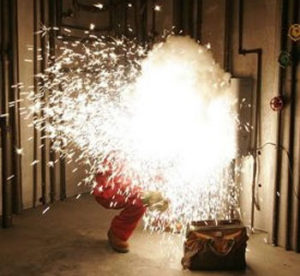Do You Need An Arc Flash Study?
Concerned about NFPA 70E compliance and worker safety?
Bertke Electric can perform an arc flash hazard analysis to determine equipment specific arc flash incident energy levels; the flash hazard boundary along with the personal protective equipment requirements. We use the best licensed Arc Flash software and technicians in the industry.
NFPA 70E, 2004, article 130.3 states, “A flash hazard analysis shall be done in order to protect personnel from the possibility of being injured by an arc flash.”
NFPA 70E, 2011, article 110.16 states, “Electrical equipment, such as switchboards, panel boards, industrial controls panels, meter socket enclosures, and motor control centers, that are in other than dwelling units, and are likely to require examination, adjustment, servicing, or maintenance while energized shall be field marked to warn qualified persons of potential electric arc flash hazards. The marking shall be located so as to be clearly visible to qualified persons before examination, adjustment, servicing, or maintenance of the equipment.”
NFPA 70E, 2004, article 130.7(C-9) “Selection of Personal Protective Equipment” states, “When PPE is selected in lieu of flash hazard analysis, Table 130.7 (C-9a) shall be used to determine the hazard/risk category for a task.”
This option requires the employer and the employee to make the determination of what level of PPE is required. This option shall NOT be used if the system has a short-circuit capacity or fault clearing times greater than what the tables were designed for.
If the system has been improperly maintained or has underrated equipment installed, it is a VIOLATION of the NEC. Therefore, the guidelines provided by the NFPA70E may not adequately protect your employees.
Personal Protective Equipment, “PPE”
PPE is used to limit the injury incurred during a fault to a level no greater than the exposure of bare skin to an open flame for approximately 1 second (approx. 1.2 cal /cm², a curable 2nd degree burn). If an Arc Flash study has not been performed at your installation, NFPA 70E has several tables that your “qualified personnel” should apply when determining PPE. In some cases the PPE worn by your “qualified personnel” is oversized for a certain task in a specific location. In other cases where improper equipment is installed or existing equipment is maintained improperly, the Arc Flash energy could be much greater than what their PPE can protect them from. If a fault has an Arc Flash energy greater than 40 cal/cm² the pressure wave will be so great that PPE can no longer provide adequate protection. Our Arc Flash study provides suggestions on how to reduce Arc Flash energy to safer levels, and it also points out improperly maintained and installed equipment.
How to Reduce Arc Flash Energy
There are three ways that Arc Flash energy can be decreased. First, the available short circuit current from the utility could be decreased (probably not possible). Second, the impedance in the local power distribution system could be increased (may be difficult and/or expensive). Third, the trip time of protective devices could be decreased. One of the more common suggestions that we have made to reduce Arc Flash energy is circuit breaker trip adjustment. The adjustment of circuit breaker tripping devices can decrease the amount of Arc Flash energy that is the result of a fault. Care must be taken when implementing this solution, as protective device coordination may be affected when reducing the trip time of protective devices. A benefit of decreasing the Arc Flash energy is that it could lower the level of PPE required.
Why should we perform an Arc Flash Study for you?
An Arc Flash study is not required by the NEC, but Arc Flash equipment warning labels are. If you do not have any Arc Flash labels now, you need to install them.
These labels are included in our Arc Flash study.
An Arc Flash study may be required by the NFPA 70E.
If your system falls outside the boundaries set for the NFPA 70E PPE tables, then an Arc Flash study is required.
We provide calculated Arc Flash energy values and labels that will be a key part of your Electrical Safety training
If your electrical personnel do not know what level of PPE is required for a task, as per NFPA 70E, you need to inform them.
We inform you of the required NFPA 70E PPE level and provide a detailed Arc Flash label, which can be placed on equipment.
Do you have improperly maintained or installed equipment that would cause the increase of Arc Flash Energy or increase the potential for a fault to occur?
Your system will be thoroughly analyzed as a part of the Arc Flash energy calculations.
The following are common areas of concern:
- Circuit breaker trip settings
- Using Motor Circuit Protectors “MCPs” as feeder breakers
- Under-rated or improperly sized fuses and circuit breakers
- Under-rated Motor Control Center “MCC” buss bracing
- Under-rated MCC starters and feeder breakers
- Under-rated Switchgear, Switchboards, and Panel boards
So, why not let us give you a quote to perform a detailed study that will include the required labels, required level of PPE details, and suggestions on how to decrease the available Arc Flash energy?


